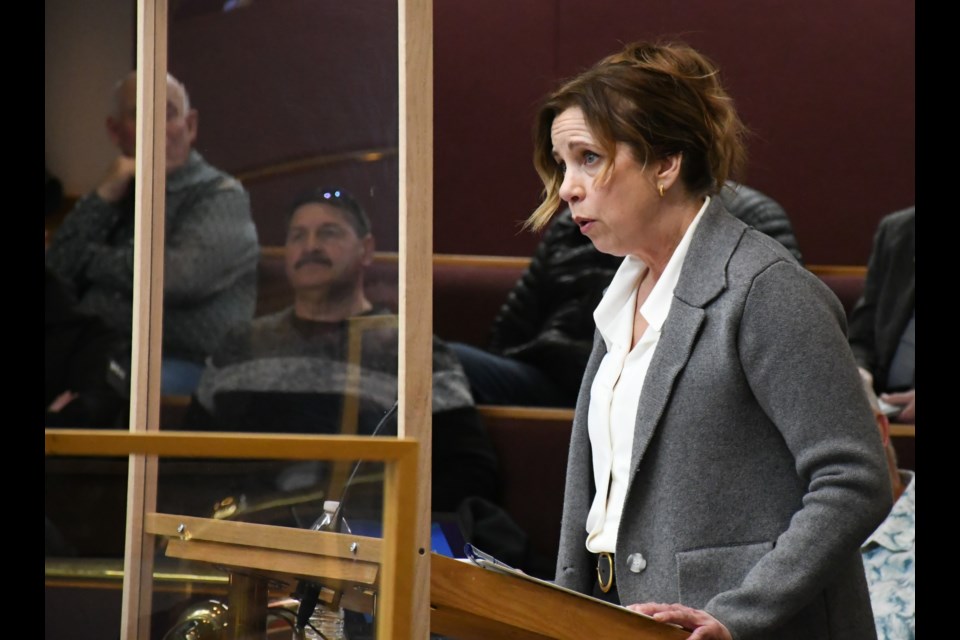The Saskatchewan Assessment Management Agency (SAMA) has made several changes to this year’s commercial property valuation model — like reducing the number of cap rates — using results from last year’s appeal process.
Nancy Wollner, manager of SAMA’s Moose Jaw office, spoke to city council during its March 27 regular meeting about those changes and their rationale.
Summary of changes
Below are some changes SAMA made to this year’s model.
Retail, office and strip commercial properties have been grouped as general commercial and then stratified (arranged) by the number of storeys, with one-storey groups sub-stratified by size. However, restaurants remain by themselves and are arranged by size.
Mixed-used properties — a business and housing in the same building — remain by themselves and are stratified by storeys. Also, auto/machinery dealerships remain by themselves.
SAMA has arranged warehouses by size, with the smaller-sized group sub-stratified by quality.
Retail multi-storey, retail one-storey and smaller than 256 square metres (2,800 square feet), high-quality offices, strip commercial smaller than 675 square metres (7,500 square feet), and certain warehouses have decreased in value.
Groups that have increased in value include retail one-storey and larger than 2,800 square feet, low-quality offices, strip commercial over 7,500 square feet, restaurants of both size groups, mixed-use one-storey, auto-machinery dealerships and various classes of warehouses.
Perhaps most importantly, the number of cap rates has decreased to 11 categories from 14.
Income approach
SAMA does not use a business’ income during its assessment practices, but instead, values commercial properties using their typical rental income-generating potential as of the base market date of Jan. 1, 2019, Wollner explained.
That approach reflects the potential rental income the business owner could receive in the market, she continued. Meanwhile, SAMA’s income-based approach consists of the rent model and the cap rate model.
SAMA develops the rent model using income and expense data from business owners. It reviews the reported information and adjusts as needed. The result is the property’s net operating income.
“The net operating income … is not based on the number of pizzas sold or the number of clothing items sold,” said Wollner.
SAMA calculates its cap rate model — net operating income divided by sale price — by applying the rent model to sold properties. The agency then groups similar properties by sales cap rates.
Further, the agency analyzes the cap rates to find variables —size, quality, number of storeys — that can affect the values. SAMA then uses the median cap rate as the model cap rate for a specific group or stratification.
The model’s goal is to generate assessed values that closely represent the actual sale prices of similar properties, said Wollner. The cap rate represents the ratio between the predicted rent and sale price; the sale price in the equation is the known value.
For example, a property that sells for $300,000 and has an income of $15,000 has a cap rate of five per cent. Conversely, a property that sells for $300,000 and has income of $20,000 has a cap rate of 6.67 per cent.
Therefore, a property’s predicted rental income divided by the applicable cap rate equals its assessment value.
Provincial use
The income approach for general commercial properties is only used in Regina, Saskatoon, Moose Jaw, Swift Current, Yorkton, Weyburn and Estevan, said Wollner. In 2022, those municipalities had cap rates of, respectively, 85, 12, 14, 12, seven, 10 and 10.
Having multiple cap rates is not an error since they reflect market data, she continued. Further, the numbers are not arbitrary because SAMA determines them using sales evidence and analyzing factors that influence the values.
“Careful consideration is given when reviewing the sale of comparability and value-influencing factors … ,” Wollner said. “Changes in the sales data can result in changes to the model.”
SAMA annually reviews the cap rate model to determine whether any re-modelling is necessary due to changes in data from the appeal process, assessment case law and assessment legislation, she continued.
For this year’s valuation, SAMA changed the cap rate model because it discovered sales data changes through last year’s provincial appeal process and because of new case law decisions.
“SAMA acknowledges the importance and integrity of the appeal process to ensure transparency and fairness in the assessment system,” Wollner said.
She added that SAMA staff are willing to speak with property owners to explain their assessments and answer any questions.
The next regular council meeting is Monday, April 10.




